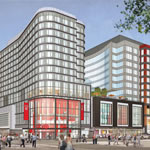Vision
The neighborhood surrounding Boston’s Fenway Park, like much of Boston, is historic, dense, and busy. Even as new mixed-use buildings, restaurants, and residential towers emerge from the site of former surface parking lots and gas stations, the picturesque streetscapes are marked by their proximity to Fenway—the oldest Major League Baseball stadium in the United States. An average of 33,000 fans per game attend during baseball season, which brings congestion to the area, in addition to the 40,000 daily employees and 80,000 university students already moving through what is known as the Fenway Triangle.
It’s an area ripe for development, and for more than a decade, the Boston-based firm Samuels & Associates has been developing in the Fenway neighborhood. The firm has created the Fenway Triangle Trilogy, beginning with a one million-square-foot mixed-use project and a second mixed-use project with ground-floor retail, 200 residential units, and a 100,000-square-foot health center. The most recent project, The Van Ness, a 600,000-square-foot mixed-use project and future home of Boston’s first City Target, rounds out the trilogy and will be completed in 2015 with a LEED Gold certification.

The Van Ness building has a fourth-floor rooftop park and garden above its retail spaces. The mixed-use development will be Samuels & Associates’ first LEED Gold development in the Fenway neighborhood though its two prior Fenway Triangle projects will also be pursuing LEED-EB certification.
Village
“When the firm first started meeting with community groups and planning officials, it was clear that the area should become a mixed-use urban village,” says Abe Menzin, the vice president of development at Samuels & Associates. The neighborhood is a truly transit-oriented location, with the Longwood Medical Area and Boston’s Back Bay within walking distance and access to the Fenway MBTA stop and the Yawkey Station Commuter Rail Station. It now is a well-traveled area, yet prior to development, key parcels were used mainly as surface parking lots and were not contributing to the vision for the neighborhood as a transit-oriented urban village. “We take the long view of development,” Menzin says. “With any project, we take a holistic approach to the neighborhood. The scale and design of the project will help realize the urban village vision for this neighborhood.”
Informed largely by the strategic infill nature of The Van Ness and associated Fenway Triangle projects, as well as strong community connectivity, the current project is being constructed to LEED Gold specifications. The Fenway Triangle Trilogy and 1330 Boylston Street buildings were designed prior to LEED and were retrofitted recently with green features including energy conservation measures and green roofs. Landmark Center, a nearby Samuels & Associates property, is a one million-square-foot mixed-use project that will retroactively target LEED EB certification, helping unify the neighborhood under a ‘green’ umbrella.
 Value
Value
Before Samuels & Associates started construction on The Van Ness building, the site was occupied by a parking garage, surface parking lots, and functionally obsolete automotive uses. The firm was able to fill the spaces with short-term tenants to maintain activity in the area and bring in revenue while it prepared for constructing The Van Ness. “We do this throughout the neighborhood, so that when we buy new buildings, they’re not sitting empty and underused during the predevelopment process,” Menzin says. “They need to contribute to the streetscape until they’re redeveloped.”
The ground floor of The Van Ness is dedicated to retail, and the second, third, and fourth floors will have Boston’s first City Target as its main tenant. The residential tower and office tower begin above the fourth floors and are separated by an urban garden for residents that connects the two buildings four stories above street level. The Van Ness uses a high-efficiency central mechanical plant, which will result in more than 20 percent energy savings annually upon completion. Additionally, the new structure uses low-flow plumbing and water fixtures and low-VOC finishes throughout, making the building a mixed-use project that is both clean and well-connected.
“We’re also making big steps in implementing highly granular metering systems to monitor tenant utilities usage at The Van Ness,” Menzin says. “It will help people keep track of individual tenants’ actual consumption, and lead to better, smarter practices and more incentives for tenants to conserve energy. We are fortunate to be working with a forward-thinking financial partner, who understands that improving the sustainability of each of our real estate projects improves both the environment in which the buildings operate and the economic value of the assets.”

